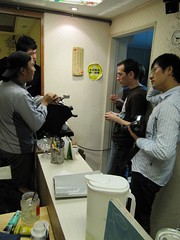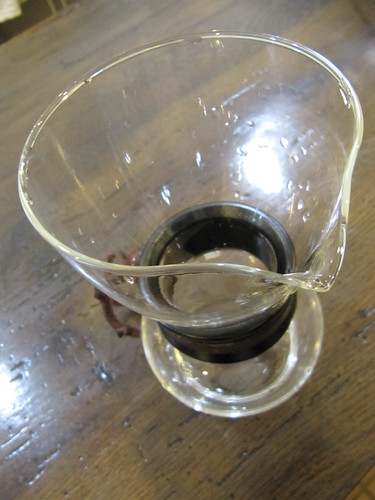Tuesday, December 29, 2009
Hario 'woodneck' design and some thoughts on hand pour
Sunday, December 20, 2009
Pour over videos from Taiwan/Japan
The following is a famous very old school Japanese roaster doing his pour over method on TV. His book on coffee roasting and brewing is interesting, techniques on double roasting, dark roasting, and the benefits of aging/aged coffees. About as far from barismo philosophy as you can get so you will understand we are not endorsing this method, it's just interesting to view. I personally think the bit at the end where the hosts get into the brewing is the most entertaining part.
Next up is Jet from Bella Taiwan doing a quick and easy continuous single 1 cup 2 minute brew. It's closer to methods we like to use at the moment on our own coffees for a 1 cup but the timing may be different. Of course, every coffee behaves differently and so do different roast styles so match it to personal taste.
After that is a demo of the stop and go method. We use variations of this for larger 2 and 3 cup brews. It involves pouring a little faster and relies on setting the grind well to control the drainage. I had been using this style for a one cup until I finally got comfortable with the continuous pour.
The last video is the type of method I understand Osir of Taiwan does. It involves a coarse grind, lots of volume, and a rapid continuous pour. This method seems more in line with the old school Japanese methods I have seen but it's not one we use.
So there are some basic pour over ideas to get people started.
Wednesday, December 16, 2009
Catching up with old friends
I have just recently gotten back from a week and a half tour of Taiwan and a brief stop in Tokyo, Japan. It will take me a little while to collect my thoughts and organize my photos but there is a lot to discuss. Tea farms, equipment manufacturers, and a drop in with Hario Japan that all will be discussed in the next few weeks.
First off, it's worth noting something that came as a shock to us. Just after visiting with Simon Hsieh in Taipei, we discovered Simon scored two very high scores on coffeereview to take the top two spots in a ranking of 2009 best sellers. I want to say congratulations to Simon and I hope he gets worthy notice for his roasting skills and ability. As a student of his in roasting and brewing methods, I can only wish him well.

Strangely enough, we finished 4th in the same poll rather unexpectedly. The request for coffees to be reviewed was for best sellers of 2009, not the sexy premium lots but the ones that have performed well in sales. I believe at the time we sent the coffees, we were nearly out of our Costa Rica Helsar de Zarcero and just discontinued our Kenya Kiandu in drip so our lineup was slim.
The Koke scored a 94pt review which we'll happily accept. We only roast this coffee as an espresso as it is very popular in our cafe accounts and is a component of more than one of the Sonata series espresso blends. Since we only roast it as espresso, we took a risk that it would not fare well on the cupping table but we came out fine.
Simon and I only had a short time to exchange coffees, catch up, and brew some Syphon before we had to keep on schedule but it was good seeing him again.

